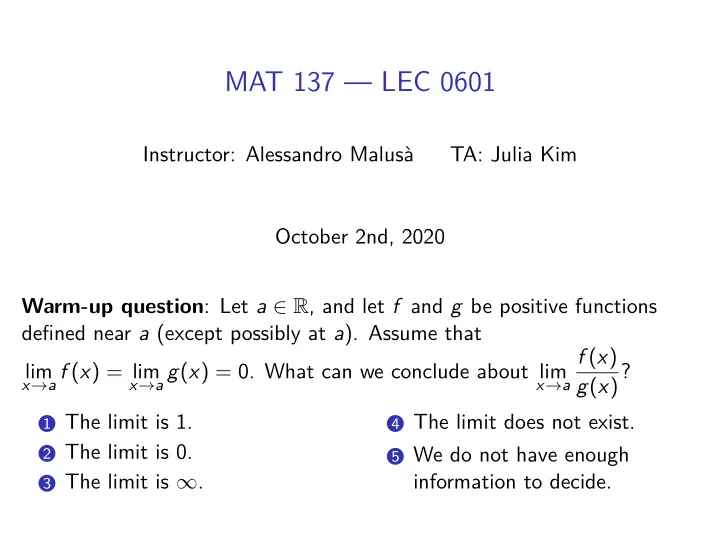

MAT 137 — LEC 0601 Instructor: Alessandro Malusà TA: Julia Kim October 2nd, 2020 Warm-up question : Let a ∈ R , and let f and g be positive functions defined near a (except possibly at a ). Assume that f ( x ) x → a f ( x ) = lim lim x → a g ( x ) = 0. What can we conclude about lim g ( x )? x → a 1 The limit is 1. 4 The limit does not exist. 2 The limit is 0. 5 We do not have enough 3 The limit is ∞ . information to decide.
A theorem about limits Let f be a function with domain R such that x → 0 f ( x ) = 3 lim Prove that � = 15 lim � 5 f (2 x ) x → 0 directly from the definition of limit. Do not use any of the limit laws.
A theorem about limits Let f be a function with domain R such that x → 0 f ( x ) = 3 lim Prove that � = 15 lim � 5 f (2 x ) x → 0 directly from the definition of limit. Do not use any of the limit laws. 1 Write down the formal definition of the statement you want to prove.
A theorem about limits Let f be a function with domain R such that x → 0 f ( x ) = 3 lim Prove that � = 15 lim � 5 f (2 x ) x → 0 directly from the definition of limit. Do not use any of the limit laws. 1 Write down the formal definition of the statement you want to prove. 2 Write down what the structure of the formal proof should be, without filling the details.
A theorem about limits Let f be a function with domain R such that x → 0 f ( x ) = 3 lim Prove that � = 15 lim � 5 f (2 x ) x → 0 directly from the definition of limit. Do not use any of the limit laws. 1 Write down the formal definition of the statement you want to prove. 2 Write down what the structure of the formal proof should be, without filling the details. 3 Rough work.
A theorem about limits Let f be a function with domain R such that x → 0 f ( x ) = 3 lim Prove that � = 15 lim � 5 f (2 x ) x → 0 directly from the definition of limit. Do not use any of the limit laws. 1 Write down the formal definition of the statement you want to prove. 2 Write down what the structure of the formal proof should be, without filling the details. 3 Rough work. 4 Write down a complete proof.
Proof feedback 1 Is the structure of the proof correct? (First fix ε , then choose δ , then ...) 2 Did you say exactly what δ is? 3 Is the proof self-contained? (I do not need to read the rough work) 4 Are all variables defined? In the right order? 5 Do all steps follow logically from what comes before? Do you start from what you know and prove what you have to prove? 6 Are you proving your conclusion or assuming it?
Rational limits Consider the function ( x − 1)(2 + x ) h ( x ) = x 2 ( x − 1)(2 − x ) . • Find all real values a for which h ( a ) is undefined. • For each such value of a , compute lim x → a + h ( x ) and lim x → a − h ( x ). • Based on your answer, and nothing else, try to sketch the graph of h .
Before next class... • Watch videos 2.12, 2.13. • Download the next class’s slides (no need to look at them!)
Recommend
More recommend